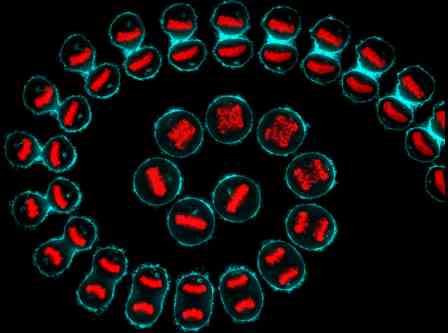Introduction to the Hallmarks of Cancer

In 2000, Robert Weinberg and Douglas Hanahan published a review article in the journal Cell titled “The Hallmarks of Cancer“. It was a seminal paper in every sense of the word; downloaded 20,000 times a year between 2004 and 2007, with over 15,000 citations in other research papers. In 2011, Weinberg and Hanahan updated their list by proposing four more new Hallmarks of Cancer, bringing up the list to Ten Hallmarks of Cancer.
A composite from a time-lapse of a HeLa cell (cervical cancer) undergoing cell division. Cellular structures have been visualized using cyan (cell membrane) and red (DNA). Image Credit: Kuan-Chung Su, London Research Institute, Cancer Research UK, Wellcome Images.
Why is this paper so important? Cancer, as we know by now, is an incredibly complicated disease. A single tumor sample could have over a hundred different mutations; nearly one in every two hundred genes in the human genome. If two breast cancer specimens are compared, the set of mutated genes are far from identical. Every tumor is unique. Weinberg and Hanahan simplified this dauntingly complex disease to six underlying principles. The hugely complicated beast that is cancer, so diverse that even the same organ can have many different tumor types, was reduced to just six common traits that every single cancer shares, to facilitate that transformation from a normal cell to a cancer cell. It answers the ‘how does cancer happen’ question very elegantly, and we gain insight into all the different things that go wrong in a cancer cell.
However, the science is not accessible to the public because the molecular mechanisms described require a specialist knowledge in the field of cell biology. Over the coming weeks, I will go through each of these Hallmarks in detail. I will explain the normal processes that occur inside the cell and then explain what goes wrong with this process in a cancer cell.
Cancer is so prevalent, and is a topic that we hear about on a daily basis. Cancer is also deeply personal; we know people who are directly affected by cancer, either themselves or a loved one. Not everyone has the knowledge to understand what is going on, and it can be very scary to hear the jargon from a doctor or an oncologist. To many people, cancer is the big scary ‘C-word’. Trying to research it online is not usually helpful, as even Wikipedia has a confusingly large amount of jargon. This series will address that knowledge gap. It will demystify cancer, and answer the question ‘why does cancer happen?’
This article originally appeared on Know The Cosmos
Follow Scientific American on Twitter @SciAm and @SciamBlogs. Visit ScientificAmerican.com for the latest in science, health and technology news.
© 2013 ScientificAmerican.com. All rights reserved.

